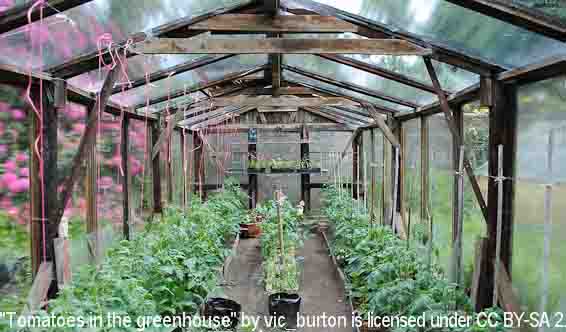- Home
- How to Grow Vegetables A-Z
- ...TOMATOES!
- Growing Tomatoes in a Greenhouse
Growing Tomatoes in a Greenhouse
Some Practical Considerations
So, you’re dreaming of growing tomatoes in a greenhouse... a worthy dream! Tomatoes are one of the most expensive fresh foods you can buy in the store, and even then they are never a match for the taste of homegrown tomatoes.
 Growing Tomatoes in a Greenhouse
Growing Tomatoes in a GreenhouseI’m going to presume that you’re dreaming about growing greenhouse tomatoes in the wintertime, because most ordinary gardeners don't use greenhouses in the summer.
I'm going to provide enough information to help you decide if greenhouse growing will be cost-effective in your situation.
It's so hard to put our vegetable gardening on hold through the winter months, and I have often dreamed about having a wintertime greenhouse garden myself, bursting with tomatoes, fresh lettuce, and maybe some carrots, too!
Growing tomatoes in greenhouse settings is not as simple as growing tomatoes outside in the summer. There are a number of factors to consider that outdoor gardeners don’t usually think about, including warmth, light, airflow, and water.
Warmth
For many, the dream of growing tomatoes in a greenhouse in the winter seems like heaven, and the first thought is of warmth. A relatively clear-panel greenhouse traps heat because the incoming short-wave radiation from the sun passes through and enters the ground, which warms up and then radiates longer-wave radiation (heat) back out. This longer-wave radiation cannot pass through the glass or polycarbonate as easily, and the heat is effectively trapped inside, warming things up inside.
But how much things warm up inside is relative to how cold it is outside. If it’s 30°F outside, the inside of the greenhouse is going to be a lot warmer than if it is -10°F outside. In almost all wintertime settings, the heat radiated by retained sunshine will not be sufficient by itself for growing tomatoes in a greenhouse.
For tomatoes to begin ripening and turn red on the vine, they need temperatures of at least 68°F, so chances are you will need to provide auxilliary heat. Be sure to include the costs of a heater, installation and fuel in your cost projections.
Light
Light would seem to be a no-brainer when considering the feasibility of growing tomatoes in greenhouse settings. But believe it or not, there may not be sufficient natural light in the winter months for tomatoes to grow. This is a matter of latitude, or how far north or south you are. Not only are the days shorter, but the sun does not rise as high in the sky in the winter, and so the amount of light is not as great.
This brings up the concept of the "Persephone period". If you live where there are less than 10 hours a day of sunlight, you'll have trouble getting tomatoes to grow. For more on this check out the article on cold frame winter vegetable gardening.
If you live in the southern tier of the US and just want to keep tomatoes above ambient temperatures, you may be able to succeed without supplemental lighting. But if you live in the northern tier, you will also have to factor in the cost of lighting to successfully grow tomatoes in a greenhouse in the wintertime.
Water and Airflow
Plants "breathe", but in the reverse way that we do. They "breathe" in carbon dioxide and breathe out oxygen, which means that they need some fresh air exchange. They also need air circulation to prevent localized oxygen buildup, which is never a problem outside in nature. Air circulation is also important in greenhouses to decrease the incidence of fungal diseases, which can otherwise be problematic. If you do not have fans in your greenhouse already, you will have to factor in the cost of fans as well.
The final consideration is water. Tomatoes are thirsty plants, and in the winter you will need an unfrozen in-greenhouse supply of water. Schlepping water in buckets from the house gets old pretty quickly when you are watering plants! Depending on your frost depth, you may need to install a deep, subsurface water line into your greenhouse.
Overall Cost Effectiveness
None of these considerations is insurmountable, but together they may mean that it might not be cost effective to try growing tomatoes in a greenhouse in the wintertime. Warmth, light, water and airflow are real requirements for growing tomatoes, so the realistic cost of supplying them should be considered before embarking on a dream of wintertime greenhouse tomatoes.
Growing greens in a greenhouse in the wintertime is a more do-able adventure for most people, as greens have much lower temperature and light requirements than tomat
Help share the skills and spread the joy
of organic, nutrient-dense vegetable gardening, and please...
~ Like us on Facebook ~
Thank you... and have fun in your garden!
Affiliate Disclaimer
This website contains affiliate links to a few quality products I can genuinely recommend. I am here to serve you, not to sell you, and I do not write reviews for income or recommend anything I would not use myself. If you make a purchase using an affiliate link here, I may earn a commission but this will not affect your price. My participation in these programs allows me to earn money that helps support this site. If you have comments, questions or concerns about the affiliate or advertising programs, please Contact Me.Contact Us Page



